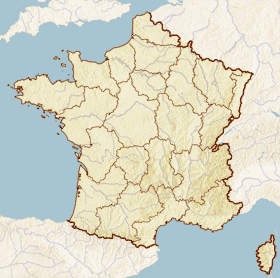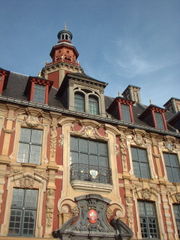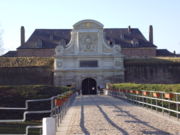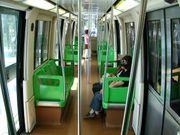Lille
2007 Schools Wikipedia Selection. Related subjects: European Geography
| Ville de Lille | ||
|
 |
|
| New city flag | Traditional coat of arms | |
| Motto: – | ||
| Location | ||
|
||
| Coordinates | ||
| Time Zone | CET (GMT +1) | |
| Administration | ||
|---|---|---|
| Country | France | |
| Région | Nord-Pas de Calais | |
| Département | Nord (59) | |
| Intercommunality | Urban Community of Lille Métropole |
|
| Mayor | Martine Aubry ( PS) (since 2001) |
|
| City Statistics | ||
| Land area¹ | 39.51 km² | |
| Population² | 10th in France | |
| - 2004 estimate | 226,800 | |
| - Density | 5,740/km² (2004) | |
| Urban Spread | ||
| Urban Area | 450 km² (1999) | |
| - Population | 1,000,900 (1999) | |
| Metro Area | 975 km² (1999) | |
| - Population | 1,143,125 (1999) | |
| ¹ French Land Register data, which excludes lakes, ponds, glaciers > 1 km² (0.386 sq. mi. or 247 acres) and river estuaries. | ||
| ² Population sans doubles comptes: single count of residents of multiple communes (e.g. students and military personnel). | ||
Lille (Dutch: Rijsel, Ryssel in old texts) is the main city of France's fourth largest metropolitan area (consisting of Lille, Roubaix, Tourcoing and their suburbs). It is located to the country's north, on the Deûle River. It is the capital of the Nord-Pas de Calais région. It is also the préfecture (capital) of the Nord département. It lies near the border with Belgium and its Dutch name is Rijsel.
The city of Lille absorbed Lomme on February 27, 2000. Their combined population at the 1999 census was 212,597 inhabitants. The whole metropolitan area of Lille, both on French and Belgian territory ( Kortrijk, Tournai) was estimated in 2000 at around 1,730,000 inhabitants, ranking as one of the major metropolitan areas of Europe.
History
In the 19th century Lille became the centre of French industry due to the large nearby coal deposits. It thus became a central part of the country's rail network.
Ancient history
The legend of " Lyderic and Phinaert" puts the foundation of the city of "L'Isle" at 640. Although the first mention of the town appears in archives from the year 1066, some archeological digs seem to show the area as inhabited by as early as 2000 BCE, most notably in the modern-day quartiers of Fives, Wazemmes, and Old Lille.
The name Lille comes from insula or l'Isla, since the area was at one time marshy. This name was used for the Count of Flanders' castle ( Château du Buc), built on dry land in the middle of the marsh.
The Count of Flanders controlled a number of old Roman cities ( Boulogne, Arras, Cambrai) as well as some founded by the Carolingians ( Valenciennes, Saint-Omer, Gand, Brugge, Anvers). The County of Flanders thus extended to the left bank of the River Escaut, one of the richest and most properous regions of Europe. The original inhabitants of this region were the Celts, who were followed by the Menapiens, the Morins, the Atrébates, and the Verviens, Germanic tribes. From 830 until around 910, the Vikings invaded Flanders. After the destruction caused by Norman and Hungarian invasion, the eastern part of the region fell under the eyes of the area princes. It is in this context that the city was created.
Middle ages
From the 12th century, the fame of the Lille cloth fair began to grow. In 1144 Saint Sauveur parish was formed, which would give its name to the modern-day quartier Saint-Sauveur.
The counts of Flanders, Boulogne, and Hainaut came together with England and the Holy Roman Empire of Germany and declared war on France and King Philippe Auguste, a war that ended with the French victory at Bouvines in 1214. Count Ferrand of Portugal was imprisoned and the county fell into dispute: it would be his wife, Jeanne, Countess of Flanders and Constantinople, who ruled the city. They say she was well-loved by the residents of Lille, who by that time numbered 10,000.
In 1224, the monk Bertrand of Rains, doubtlessly encouraged by local lords, tried to pass himself off as Baldwin I of Constantinople (the father of Jeanne of Flanders), who had disappeared at the battle of Adrianople. He pushed the kingdoms of Flanders and Hainaut towards sedition against Jeanne in order to recover his land. She called her cousin, Louis VIII ("The Lion"). He unmasked the imposter, who Countess Jeanne quickly had hanged. In 1226 the King agreed to free Ferrand of Portugal. Count Ferrand died in 1233, and his daughter Marie soon after. In 1235, Jeanne granted a city charter by which city governors would be chosen each All Saint's Day by four commissioners chosen by the ruler. On February 6th, 1236, she founded the Countess's Hospital ( L'hospice de la comtesse), which remains one of the most beautiful buildings in Old Lille. It was in her honour that the hospital of the Regional Medical University of Lille was named "Jeanne of Flanders Hospital" in the 20th century.
The Countess died in 1244 in the Abbey of Marquette, leaving no heirs. The rule of Flanders and Hainaut thus fell to her sister, Marguerite of Flanders, then to Marguerite's brother, Guy de Dampierre. Lille fell under the rule of France from 1304 to 1369, after the battle of Mons-en-Pévèle.
The county of Flanders fell to the Duchy of Burgundy next, after the 1369 marriage of Marguerite de Male, Countess of Flanders, and Philippe II le Hardi, Duke of Burgundy. Lille thus became one of the three capitals of said Duchy, along with Brussels and Dijon. By 1445, Lille counted some 25,000 residents. Philippe le Bon, Duke of Burgundy, was even more powerful than the King of France, and made Lille an administrative and financial capital.
On February 17, 1454, one year after the taking of Constantinople by the Turks, Philippe le Bon organised a Patagruelian banquet at his Lille palace, the still-celebrated " Feast of the Pheasant". There the Duke and his court undertook an oath to Christianity.
In 1477, at the death of the last duke of Burgundy, Charles the Bold, Mary of Burgundy married a Hapsburg, Maximilian of Austria, who thus became Count of Flanders. At the end of the reign of the Holy Roman Emperor Charles V, Spanish Flanders fell to his eldest son, and thus under the rule of Philip II of Spain, King of Spain. The city remained under Spanish rule until the reign of Philip IV of Spain.
The modern era
The 16th century was marked, above all, by the outbreak of the Plague, a boom in the regional textile industry, and the Protestant revolts.
The first Calvinists appeared in the area in 1542; by 1555 there was anti-Protestant repression taking place. In 1578, the Hurlus, a group of Protestant rebels, stormed the castle of the Counts of Mouscron. They were removed four months later by a Catholic Wallon regiment, after which they tried several times between 1581 and 1582 to take the city of Lille, all in vain. The Hurlus were notably held back by the legendary Jeanne Maillotte. At the same time (1581), at the call of England's Queen Elizabeth I , the north of the Spanish Netherlands, having gained a Protestant majority, successfully revolted and formed the United Provinces.
In 1667, King Louis XIV (the Sun-King) successfully laid siege to Lille, resulting in it becoming French in 1668 under the Treaty of Aix-la-Chapelle, provoking discontent among the citizens of the prosperous city. A number of important public works undertaken between 1667 and 1670, such as the Citadel (erected by Vauban), or the creation of the quartiers of Saint-André and la Madeleine, enabled the King to gain the confidence of his Flemish subjects.
During five years, from 1708 to 1713, the city was occupied by the Dutch, during the War of the Spanish Succession. Throughout the 18th century, Lille remained profoundly Catholic, which explains why the city did not really take part in the French Revolution, though there were riots and the destruction of churches. In 1790, the city held their first municipal elections.
After the French Revolution
In 1792, in the aftermath of the French Revolution, the Austrians, then in the United Provinces, laid siege to Lille. The " Column of the Goddess", erected in 1842 in the "Grand-Place" (officially named La Place du Général de Gaulle), is a tribute to the city's resistance, led by Mayor François André. Although Austrian artillery destroyed many houses and the main church of the city, the city did not surrender and the Austrian army left after eight days.
The city continued to grow, and by 1800 held some 53,000 residents, leading to Lille becoming the county seat of the Nord départment in 1804. In 1846, a rail line connecting Paris and Lille was built.
At the beginning of the 19th century, Napoleon I's continental blockade against the United Kingdom led to Lille's textile industry developing itself even more fully. The city was known for its cotton, and the nearby towns of Roubaix and Tourcoing worked wool.
In 1853, Alexandre Desrousseaux composed his famous lullaby Dors mon p'tit quinquin. In 1858, an imperial decree led to the annexation of the adjacent towns of Fives, Wazemmes, and Moulins. Lille's population was 158,000 in 1872, growing to over 200,000 by 1891. In 1896 Lille became the first city in France to be led by a socialist, Gustave Delory.
By 1912, Lille's population was at 217,000: the city profited from the Industrial Revolution, particularly via coal and the steam engine. The entire region had grown wealthy thanks to the mines and to the textile industry.
World War I
From October 4th to 13th, 1914, the troops in Lille were able to trick the enemy by convincing them that Lille possessed more artillery than was the case; in reality, the city had only a single cannon. Despite the deception, the German bombardments destroyed over 2,200 buildings and homes. When the Germans realized they had been tricked, they burned down an entire section of town, subsequently occupying the city. Lille was liberated by the British on October 17th 1918, when General Sir William Birdwood and his troops were welcomed by joyous crowds. The general was made an honorary citizen of Lille on October 28th of that year.
The Années Folles, the Great Depression, and the Popular Front
In July 1921, at the Pasteur Institute in Lille, Albert Calmette and Camille Guérin discovered the first antituberculosis vaccine, known as BCG ("Bacille de Calmette et Guérin").
From 1931 Lille felt the repurcussions of the Great Depression, and by 1935 a third of the city's population lived in poverty. In 1936, the city's mayor, Roger Salengro, became Minister of the Interior of the Popular Front, eventually killing himself after right-wing groups led a slanderous campaign against him.
World War II
Lille was taken by the Germans in May 1940, after brief resistance by a Moroccan Infantry division. When Belgium was invaded, the citizens of Lille, still marked by the events of World War I, began to flee the city in large numbers. Although Lille was part of the zone under control of the German commander in Brussels, the city was never controlled by the Vichy government. The départments of Nord and Pas-de-Calais (with the exception of the coast, notably Dunkerque) were, for the most part, liberated in five days, from the 1st to 5th September 1944 by British, American, Canadian, and Polish troops. On September 3rd, the German troops began to leave Lille, fearing the British, who were on their way from Brussels. Following this, the Lille resistance managed to retake part of the city before the British tanks arrived. Rationing came to an end in 1947, and by 1948, some normality had returned to Lille.
Post-war to the present
In 1967, the Chambers of Commerce of Lille, Roubaix, and Tourcoing were joined, and in 1969, the Communauté urbaine de Lille (Lille urban community) was created, linking 87 communes with Lille.
Throughout the 1960s and 70s, the region was faced with some problems after the decline of the coal, mining and textile industries. From the start of the 1980s, the city began to turn itself more towards the service sector.
In 1983, the VAL, the world's first automated rapid transit underground network, was opened. In 1993, a high-speed TGV train line was opened, connecting Paris with Lille in one hour. This, followed by the opening of the Channel Tunnel in 1994 and the arrival of the Eurostar train, puts Lille in the centre of a triangle connecting Paris, London, and Brussels.
Work on Euralille, an urban remodelling project, began in 1991. The Euralille Centre was opened in 1994, and the remodeled district is now full of parks and modern buildings containing offices, shops, and apartments. In 1994 the "Grand Palais" was also opened.
Lille tried an unsuccessful bid for the organization of the Games of the XXVIIIth Olympiad in 2004.
Economy
A former major textile manufacturing centre, Lille forms the heart of a larger conurbation, regrouping Lille, Roubaix, Tourcoing and Villeneuve d'Ascq, which is France's 4th-largest urban conglomeration with a 1999 population of over 1.1 million.
Transport
Lille is an important crossroads in the European high-speed rail network: it lies on the Eurostar line to London and the French TGV network to Paris, Brussels and other major centres in France such as Marseille, Lyon ,Toulouse. It has two train stations, which stand next door to one another: Lille-Europe station (Gare Lille-Europe), which primarily serves high-speed trains and international services ( Eurostar), and Lille-Flandres station (Gare Lille-Flandres), which primarily serves lower speed trains.
The Lille Metro's VAL system (véhicule automatique léger = light automated vehicle) is a driverless metro. Line 2 is 32 km long with 43 stations, the first automatic metro line in the world, which opened on May 16, 1983. It was the longest in the world until August 31, 2002, when it was surpassed by the Vancouver SkyTrain. Trains are only 26 m long (two linked cars) and are rubber-tired. There are 60 stations which go as far as the Belgian border.
Highways
Five autoroutes pass by Lille, the densest confluence of highways in France after Paris:
- Autoroute A27 : Lille - Tournai - Brussels / Liège - England
- Autoroute A23 : Lille - Valenciennes
- Autoroute A1 : Lille - Arras - Paris / Reims - Lyon
- Autoroute A25 : Lille - Dunkirk - Calais - England
- Autoroute A22 : Lille - Antwerp - Netherlands
A sixth one — the proposed A24 — will link Amiens to Lille if built, but there is opposition to its route.
Air traffic
Lille Lesquin ( http://www.lille.aeroport.fr/) International Airport is 15 minutes from the city centre. It is the 12th most frequented French airport in number of passengers:
- around 970,000 passengers in 2001
- almost 873,000 passengers in 2003
In terms of shipping, it ranks fourth, with almost 38,000 tonnes of freight which pass through each year.
Waterways
Lille is the 3rd largest French river port after Paris and Strasbourg. The river Deûle is connected to regional waterways with over 680 km of navigatable waters. The Deûle connects to Northern Europe via the River Scarpe and the River Escaut (towards Belgium and the Netherlands), and internationally via the Lys (to Dunkerque and Calais).
Shipping statistics
| Year | 1997 | 2000 | 2003 |
|---|---|---|---|
| Millions of tonnes | 5.56 | 6.68 | 7.30 |
| By River or Sea | 8.00% | 8.25% | 13.33% |
| By Rail | 6.28% | 4.13% | 2.89% |
| By Road | 85.72% | 87.62% | 83.78% |
Education
With over 144 000 students, the metropolitan area of Lille is one of the first student cities in France. The Catholic University was founded in 1875. Today it has law, economics, medicine, physics faculties and schools. Among the most famous is EDHEC Business School founded in 1906, the ESC Lille Graduate School of Business founded in 1892, the IESEG currently ranked within the top 5, 10 and 15 business schools in France, respectively. In 1924 ESJ - a leading journalism school - was established, in 1970 three public universities (Lille I, II and III) were created, and in 1992 the Institut d'études politiques de Lille. Also, in Lille is located the Ecole Centrale de Lille, one of the five great schools of engineering in France.
Twin cities
 - Cologne and Erfurt, Germany
- Cologne and Erfurt, Germany - Esch-sur-Alzette, Luxembourg
- Esch-sur-Alzette, Luxembourg - Kharkiv, Ukraine
- Kharkiv, Ukraine - Leeds, England, United Kingdom
- Leeds, England, United Kingdom - Liège, Belgium
- Liège, Belgium - Nablus, Palestinian Authority
- Nablus, Palestinian Authority - Rotterdam, Netherlands
- Rotterdam, Netherlands - Safed, Israel
- Safed, Israel - Saint-Louis, Senegal
- Saint-Louis, Senegal - Turin, Italy
- Turin, Italy - Valladolid, Spain
- Valladolid, Spain - Buffalo,United States
- Buffalo,United States






